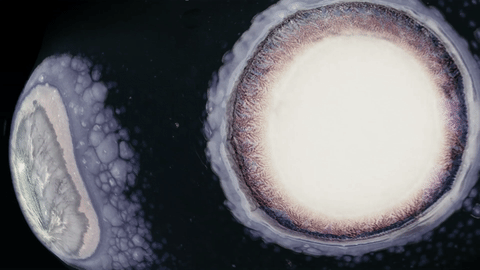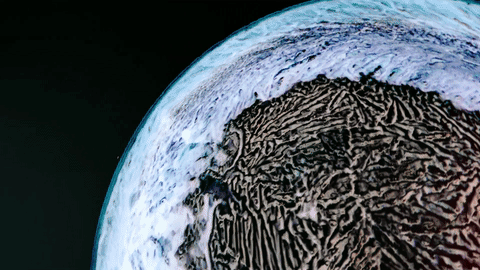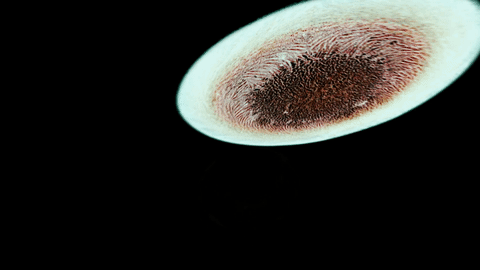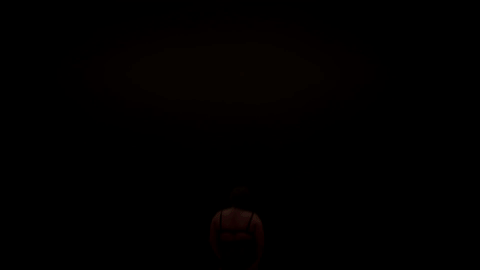Rebecca Lamarche-Vadel is a collector of big ideas that span diverse disciplines - of science, literature, dance, politics, history, philosophy, and art.
Raised in the ‘middle of nowhere’ by an art critic writer father and an artist mother, her childhood in the Brittany countryside was drenched in painting and thinking and writing and talking. Her ‘idiosyncratic and independent’ parents would invite many artists, collectors and writers to their home and Lamarche-Vadel would ‘stay under the table and listen at night to endless conversations that I would not understand.’ She began to write poetry and prolific unfinished novels, and put together theatre plays and ‘took everybody hostage to come and watch - I guess a spirit of celebration and creation was around from when I was very young.’
She moved to Paris and studied political science, history and art history at the Sorbonne, before interning at galleries and art institutions from the age of sixteen. She first curated shows based on necessity - in Paris, without spaces, money, or supportive institutions available, Lamarche-Vadel and her friends staged shows anyway, finding and creating spaces where there were none. She moved to Berlin and after successful stints producing underground art projects, she now curates for the Palais de Tokyo in Paris.
For The Fifth Sense, Lamarche-Vadel has combined her interest in experimental curation with the polish of a grand art show, creating a digital exhibition movie based on the transformative power of scent inspired by Chanel’s Nº5 L’EAU. The project brings together six female artists, taking the viewer through space and time, emotion and transmutation, and focusing on five themes of ephemerality, the body, emotion, attraction and rebirth. The film is fluid and unconfined by physical space and explores the way an exhibition and art are composed of layers and notes, just as fragrance is. Through installation, dance, sculpture, photography, spoken word and musical score, Lamarche-Vadel’s show poses the question:
What if scent could speak to you?

What impact did your early life have on your work and worldview? Our family culture for generations, the spirit of it, is still with me: this idea of challenging common values or ideas, pushing forward what we think about art,and who has the mandate to say when and where it happens. We were always talking about everything else that happens in the world - questions of art and humanity, political and social issues, so my vision was embraced by everything else around. I was physically very isolated and had a solitary childhood in the middle of endless fields and bad weather, which calls for an early sense of resilience and the need for a strong entertaining imagination. I was given something precious; the urge to doubt and explore the unknown, and I feel much safer in this zone than in any secured areas of thinking.
What does art mean for you? I do not have a one-line approach of what art is, and hope I never will, but rather how it exists within a broader world and broader perspectives, how art and creation exist and how they can hopefully be catalysts for dialogues and self understanding. Half of my family bears the heritage of war refugee migration; I guess that once you’ve experienced such feeling of dehumanisation, you can only ask yourself about how to maintain links between human beings. Creation, in all its variety and wideness is perhaps one answer, far from any dangerous canons asserting what it should be.
I do not have a one-line approach of what art is, and hope I never will


I thought of scent as an immaterial object that travels through time and space, a beautiful paradox of permanence and volatility
How did you start producing shows? It was linked to the political atmosphere in France at the time, between 2007-2009, when there were incredibly strong student protests against the government in place that was putting together different measures to fragment and fragilise the statures of students, universities, research: for three years I had almost no courses, and things were in a complete state of paralysis. I started to put together shows with friends, and we would meet at night and discuss for hours what things we could do. There was a mistrust for our future because of what the government was proposing and so it became about what we could do, and how we could invent alternatives to the system that was being brought together.
What did these early shows end up looking like? Honestly, it was more about goodwill than in putting together great shows! We had strong ideas and determination, but because we had no money and there were no spaces or institutions to promote young artists, we decided to go outside of any known spaces and put together shows in the forest, to organise parties and meetings. We would invite friends, artists, whoever wanted to join for five or six hours in the forest outside of Paris. We would choose a spot, put together the work and use the space - whatever was there, in the few hours, and then everything would disappear. It was a very interesting way for us to understand we didn't need walls or an organisation - instead it was about energies and synchronisation between people, doing a project together that had no other goal than existing ephemerally. I think our precariousness became a poetic tool, something we could explore and turn to our advantage, and thus, somehow, fight against disillusion.
I believe there is a responsibility for us all to think and discuss collectively about what arts and cultures are
Has this spirit followed you in your work? Yes. Now my projects have different dimensions and it is vital for me to be able to put on different scale shows; still put shows on at my flat for one night, and let artists imagine scenarios that will happen for a very short amount of time. It is a balance that I need; between very public shows and spaces for confidential projects that leave no traces but in the memories of those attending. Asking artists to imagine a ritual that will last for five hours is as interesting to me as bigger projects - all of them serve as a laboratory where you can try out gestures and use time, space and presence as a canvas.
Tell me about Just a Second. I was interested in the power of scent - its incredible, ungraspable forces. I thought of scent as an immaterial object that travels through time and space, a paradox of permanence and volatility. Scent allows us to experience the world, to lose control, to encounter ourselves and others, to transform our condition in a very literal way, and to feel alive. Artworks too, as much as scent, have a way of taking into hostage the invisible. They embody thoughts, emotions, projections, dreams; a poetical resistance to our condition and the reinvention of ourselves through our past, present and future experiences. ‘You who let yourselves feel: enter the breathing that is more than your own’: the poet Rainer Maria Rilke sums up quite well how human beings are permanently transformed by immaterial surrounding forces.



How do the five artworks fit into your exploration of scent? As five moments, linked through a voice and original music. In Bridget Polk’s Promises of the Ephemeral, the work looks at the power of an invisible material and the idea of fragility and time. Polk balances the rocks and you cannot know how long they will last together. These ephemeral sculptures look magical, but there’s no use of glue or any tools; it is invisible forces that hold them together before they vanish and fall.
Elizabeth Jaeger’s work is about inner mutation and transformation - the idea that you are many selves in the same envelope, the same body, all of them, the catharsis of a different moment of yourself. It plays with the idea of the real self, the past self, the idealised self, and goes against the idea of a fixed identity to something more fluid.
Sarah Schönfeld presents a photographic series of different hormones - the emotions, feelings and sentiments you go through and yet have no idea what they look like. They are territories of hope, sadness, love, attraction, desires; maps of the inside that play with scale between the micro and the cosmos.

Marguerite Humeau’s work What Happened? is about trying to understand the big enigmas of humanity that we cannot reach, through different discourses. She puts together studies by talking to as many researchers and scientists as possible until she reaches the point where nobody has the answer and has to admit that all of this is just hypothesis and we just have no clue whatsoever. The work is about a hypothesis on the first creatures that were able to create a sense of attraction and desire and belonging. Scent is about recognising someone else’s presence, triggering attraction - a question of the skin and what the skin expels as a material itself.
I also invited a very talented Japanese DJ and composer Powder to realise the sound track that is as much as an artwork as the visual ones, composing the original tracks to fit with the rhythm and dimensions of each artworks. Another element is the voice of scent that dances somehow with the artworks, playing with our vision, guiding us through what these images are and creating new mental images. The idea was to get a sense of scent playing with us too, being this ubiquitous playful presence, speaking about the way it acts, reacts, creates, evaporates.
Episode 6

How does the vogue dancing relate? Lasseindra Ninja is a choreographer, dancer and pioneer of voguing, dancing with the House of Ninja and then bringing the dance to Paris. Voguing was very well-known in the 60s in New York, a dance of emancipation and political action towards recognition and important for many communities such as black queer and LGBT. Naively I was imagining that dancers performing during voguing balls were expressing their own idealised self through dancing, but Ninja was like ‘absolutely not’. For the thirty seconds of performance on the catwalk, she explained that dancers are given the space to be the person they are, and outside of the ball scene they have to be someone else, playing a role to fit norm expectations.
I went to many balls in Paris and found immense poetry - each ball was written by the House like a poem with themes (such as horror movies) with different categories inviting the dancers to perform their own interpretation of the theme. You need a certain sense of tension, rhythm and composition within the categories and the dancers would compete within that.
For the exhibition Ninja developed a longer project Le Parfum de Cleopatre built around the idea of the dancers hypnotised by Cleopatra’s scent. Scent was used in ancient Egypt as a way for humans to reach the gods, a link between different worlds, the present and the past, the terrestrial and the celestial, and Ninja’s work plays into that.





Featured Stories
A digital journey to make the invisible, visible. Inspired by CHANEL Nº5 L’Eau.
Explore the physical and virtual elements of scent by deconstructing its unseen elements, combining the scientific yet emotive components of fragrance in a digital space.
Each individual journey is unique to the user through the interactions and tasks of each space, creating a visual and sonic world of discovery.
Please note this project contains flashing images.
Read More
